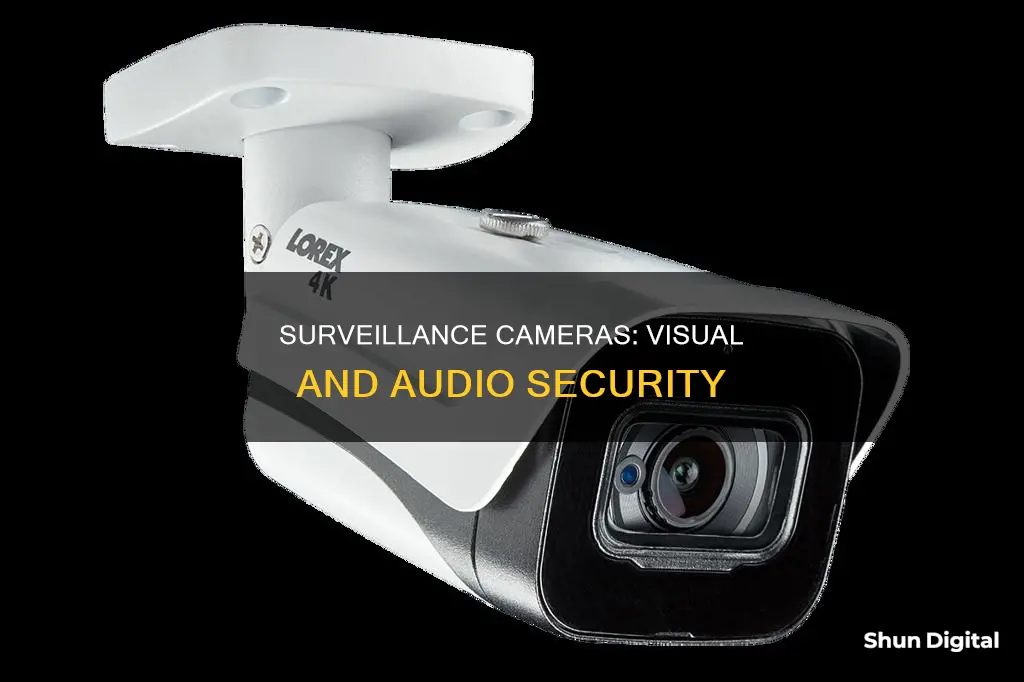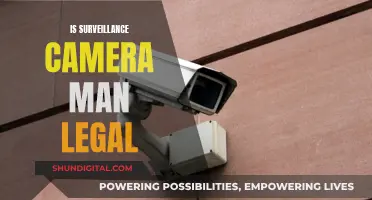
Many modern security cameras have audio capabilities, including two-way audio, one-way audio, and audio alerts. However, the legality of audio recording is more restricted than video recording, with privacy laws forbidding recording in private spaces such as bathrooms and bedrooms. The laws vary by state, with some requiring two-party consent and others only requiring one-party consent for recording. In public spaces, there is generally no expectation of privacy, but covert recording with hidden cameras is usually prohibited.
| Characteristics | Values |
|---|---|
| Audio recording capabilities | Many modern security cameras have audio recording capabilities. |
| Types of audio recording | One-way audio, two-way audio, audio alerts |
| Microphone placement | Internal or external |
| Microphone appearance | Small hole, pinhole, or speaker with dozens of holes |
| Microphone location | Near the lens, on the front, back, underside, or top of the camera |
| Audio range | Up to 6 meters for quiet speech; the range varies depending on the model and placement |
| Legality | Varies by jurisdiction; consent requirements and restrictions on recording in private spaces differ |
| Turning off audio | Can usually be disabled through the camera's app or DVR menu |
What You'll Learn
- Surveillance cameras with audio can be used to monitor babies, pets or visitors
- Two-way audio allows users to communicate through the camera
- Surveillance cameras with audio may be illegal in certain locations
- Surveillance cameras with audio may be illegal in certain situations
- Surveillance cameras with audio may be illegal without consent

Surveillance cameras with audio can be used to monitor babies, pets or visitors
Surveillance cameras with audio can be used to monitor babies, pets, or visitors.
Monitoring Babies
Baby monitors have evolved to include clear picture and sound quality, long-lasting batteries, and hardware that can survive toddlerhood. Local-video monitors are a simple option that only requires the display unit to stay within about 1,000 feet of the camera in the baby's room. Wi-Fi monitors are a more complicated option that allows remote check-ins from anywhere with cell service. Hybrid monitors work similarly to local monitors but can also be paired over Wi-Fi through an app. Audio monitors are a simple and inexpensive option that only provides audio feedback.
Monitoring Pets
Pet cameras are often home security cameras with dedicated pet-detection features. They can help you keep an eye on your pets and solve mysteries like why there is fur on the kitchen counter. The Eufy Indoor Cam C120 is a good option for monitoring pets as it has multiple storage options, can capture footage at a high resolution, and reliably detects pets' comings and goings. The Google Nest Cam is another good option as it has a dedicated pet-detection option and can distinguish between people, animals, vehicles, and general motion.
Monitoring Visitors
Surveillance cameras with audio can be used to monitor visitors, whether they are expected or unexpected. Modern Wi-Fi cameras often come with built-in microphones that can capture audio while recording video footage of motion detection events. This can be useful for revealing information not captured on video, like arguments with a person out of frame. Cameras with two-way audio can also be used to talk to visitors.
Charging Your Gear 360: A Quick Guide to Powering Up
You may want to see also

Two-way audio allows users to communicate through the camera
Two-way audio is a feature of some security cameras that allows users to communicate through the camera in real-time. This can be useful for a variety of purposes, such as:
- Talking to family members or pets
- Greeting guests or instructing couriers
- Issuing warnings to intruders
- Monitoring elderly or at-risk adults
- Communicating with employees
- Interacting with visitors at the door
Two-way audio security cameras typically have built-in microphones and speakers, so you don't need to purchase additional equipment to enable this function. However, some cameras also support external microphones and speakers, which can provide greater flexibility in placement and higher-quality audio.
When purchasing a two-way audio security camera, it is important to consider the sound quality, including the volume, clarity, and any delay in the two-way communication. Checking customer feedback, audio and video samples, and professional reviews can help ensure that you are getting a high-quality product.
In terms of legal considerations, the audio recording is generally more restricted than video recording. While the specific laws vary by location, it is generally prohibited to record audio without the consent of at least one party involved in the conversation. It is important to check the local laws and regulations before using a two-way audio security camera.
Uncover Camera Port's Stealth Mode: Here's Why
You may want to see also

Surveillance cameras with audio may be illegal in certain locations
Surveillance cameras with audio capabilities are governed by a different set of laws than those without. While video surveillance is generally allowed in public spaces, audio surveillance is subject to stricter regulations due to a person's right to privacy.
In the United States, federal law prohibits anyone from secretly recording conversations that another person believes to be private. However, this does not apply if at least one person in the conversation consents to being recorded, even if it is the person doing the recording. This is known as the one-party consent rule, and it is followed by federal law and some states.
On the other hand, some states have more stringent requirements, such as the all-party consent rule, which requires the consent of all parties involved in the conversation before recording. As of 2022, there are 11 states that require two-party consent for audio recording: California, Delaware, Florida, Illinois, Maryland, and Washington, among others.
In certain locations, such as California, it is illegal to make a video recording of communications that are considered confidential. Additionally, in most instances, the limitations of audio recording follow that of video recording. It is generally illegal to record audio or video in places where there is a high expectation of privacy, such as restrooms, toilets, bedrooms, and changing rooms.
While the presence of security cameras with audio recording capabilities can make people feel uneasy, it is important to note that they can also have benefits, such as providing evidence in legal cases or helping to protect homes and businesses from intruders or vandalism.
To ensure compliance with the law and respect for privacy, it is recommended to look into local, county, state, and federal surveillance laws before installing security cameras with audio capabilities in your home or business.
Congestion Charge Cameras: Effective or Invasive?
You may want to see also

Surveillance cameras with audio may be illegal in certain situations
Surveillance cameras with audio capabilities are becoming increasingly common, with many modern Wi-Fi cameras (also known as IP cameras) featuring built-in microphones. While these audio features can enhance security and provide additional information, they may also raise legal concerns in certain situations.
In the United States, the federal Wiretap Act prohibits the secret recording of conversations without the consent of at least one party involved. However, this act does not apply if one of the parties, such as the person doing the recording, gives consent. Beyond this federal legislation, the legality of audio surveillance varies by state, with specific regulations governing the use of electronic recordings of conversations.
As of 2022, there are 12 states that require the consent of all parties (also known as two-party consent) when it comes to audio recordings. These states include California, Washington, Florida, Illinois, and Maryland. In these states, it is illegal to record a conversation without the express consent of every participant. On the other hand, the remaining states only require the consent of one party (one-party consent), meaning an individual can record a conversation as long as they are a part of it or have given permission.
It is important to note that audio surveillance laws also apply to public and private spaces. While it is generally legal to record video in public spaces, there are often stricter regulations for audio recordings due to the expectation of privacy. Additionally, recording of any kind is typically prohibited in private areas such as bedrooms, bathrooms, and dressing rooms without the knowledge and consent of the individuals involved.
The legality of audio surveillance in the workplace also varies by state. In states like California, Connecticut, Florida, Illinois, and Maryland, it is illegal to have cameras with audio in the workplace unless express consent is obtained from all parties being recorded. In other states, the one-party consent rule applies, where only one person being recorded must consent to the audio surveillance.
To avoid legal issues, it is crucial to be aware of the specific laws and regulations regarding audio surveillance in your state and locality. Failure to comply with these laws can result in significant fines and even imprisonment.
Updating Adobe Camera Raw CS3: A Step-by-Step Guide
You may want to see also

Surveillance cameras with audio may be illegal without consent
Surveillance cameras with audio capabilities are becoming increasingly common, with many modern Wi-Fi cameras (also called IP cameras) featuring built-in microphones. While audio surveillance can be beneficial for security purposes, it is important to be aware of the legal implications, as recording audio without consent may be illegal in certain contexts.
In the United States, the federal Wiretap Act prohibits anyone from secretly recording conversations that another person believes to be private. However, this act does not apply if at least one person in the conversation consents to being recorded, even if it is the person doing the recording. This is known as the one-party consent rule, and it is followed by the majority of states. In these states, individuals can record conversations without the knowledge or consent of the other party as long as they themselves are part of the conversation.
However, it is important to note that there are 11 two-party consent states that require the consent of all participants in a conversation for it to be recorded. These states include California, Connecticut, Florida, Illinois, Maryland, Massachusetts, Michigan, Montana, Nevada, New Hampshire, Pennsylvania, and Washington. In these states, recording audio without the express consent of everyone involved is illegal and can result in strict legal consequences.
Additionally, regardless of the state, there are certain places where audio recording is prohibited due to privacy concerns. These include private spaces such as bathrooms, bedrooms, and dressing rooms. It is illegal to record audio in these areas without the knowledge and consent of the individuals being recorded.
To avoid legal issues, it is essential to be informed about the specific laws and regulations regarding audio surveillance in your state and to respect the privacy of individuals in private spaces. Failure to comply with these laws can result in severe penalties, including substantial fines and even imprisonment.
Low Power Mode: Impact on Camera Quality
You may want to see also
Frequently asked questions
Yes, many modern security cameras come equipped with microphones and speakers for audio capabilities.
There are several ways to tell if a camera has audio capabilities:
- Look for a small hole near the lens of the camera, which is where the microphone is located.
- Check for external microphones, which are usually spherical or box-shaped.
- Look for wires connected to the camera, such as Ethernet cables or hybrid coaxial cables, which are used for audio transfer.
- Check the product specifications to see if audio recording is listed as a feature.
The legality of audio recording varies depending on the jurisdiction. In some places, it may be illegal to record audio without the consent of all parties involved. It is generally prohibited in private spaces such as bedrooms, bathrooms, and dressing rooms.
Surveillance cameras with audio can provide additional security and peace of mind. They can be used to monitor pets, children, or guests in the home, and can also be used to communicate with people near the camera. Audio alerts can also be set up to notify users of specific sounds, such as breaking glass.







